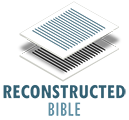Outlining A Book Of The Bible? You're Doing It Wrong
/The key to outlining a book of the Bible is to make sure you structure it the way an ancient Hebrew would. If you outline without knowing this ancient way, then you'll be missing out on a deeper understanding of the book that you're studying, or even worse, if you try to force the book into a typical outline, you could completely misunderstand what the Biblical author was trying to say. Knowing how to outline correctly can help you understand where the author was placing emphasis, and it can even help you remember Scriptures better.
Knowing How Ancient Writers Structured Their Writings Can Help Us Understand Them Better
Several years ago, I was trying to outline Genesis, but the more I tried, the more it seemed like it had no structure. It just seemed like random stories were just arbitrarily thrown together. Sure, I could have forced it into an outline and ignored the things that didn't seem to fit, but I wondered to myself if perhaps the ancient Hebrews structured there writing differently than we do. Turns out they did, and it's called chiastic structure. @@It's time to stop forcing books of the Bible into outlines they were never intended for@@. They may be using a chiastic structure instead.
How Chiastic Structure Works
The typical Western style outline looks something like this:
I. Introduction
A. Sub point 1
B. Sub point 2
II. Point 1
A. Sub point 1
B. Sub point 2
III. Point 2
A. Sub point 1
B. Sub point 2
IV. Point 3
A. Sub point 1
B. Sub point 2
V. Conclusion
Chiastic structure is more cyclical in nature. It looks like this:
A
B
C
X
C'
B'
A'
A chiasmus uses inverted parallelisms so that the words or idea in A is somehow reflected in A′.
X marks the main point and is somewhat similar to the “conclusion” in the Western outline.
Here's a chiasmus from Genesis 17:1-25:
A Abram's age
B The LORD appears to Abram
C God's first speech
D Abram falls on his face
E God's second speech (Abram's name changed, kings)
X God's Third Speech (Covenant of circumcision)
E' God's fourth speech (Sari's name changed, kings)
D' Abraham falls on his face
C' God's fifth speech
B' God "goes up" from Abraham
A' Abraham's age
Chiastic structure can be contained within a few verses or span entire books. There can also be chiastic structures within chiastic structures, creating complexity and beauty that some consider to be poetic.
This type of structure can also assist in helping you remember the Scriptures. If you can remember A, then you know that A' is reflected in some way. This was helpful in the ancient world when most teaching was orally, and the literacy rate was low.
It's also helpful to know where the author's main point is in the structure. If the main point is in the middle, and you are looking for it at the end (the conclusion), then you'll be off the mark.
Chiastic structure is much more prominent in the Old Testament, but there are plenty in the New Testament. If you don't feel that a book uses chiastic structure, then don't force it into one. Each book is unique and you'll have to determine whether it uses a chiastic structure or not.
Chiastic Structure And Mirror-Reading
Chiastic structure can be beneficial when mirror-reading. Not only does it help you grasp the overall structure of the book, but can also be useful in identifying key themes and reoccurring word/phrases, which is good to know when mirror-reading.




